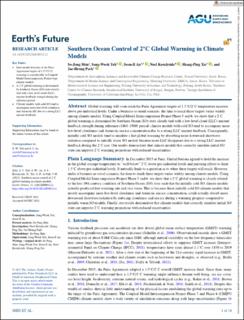Southern Ocean Control of 2°C Global Warming in Climate Models
Journal article, Peer reviewed
Published version

Åpne
Permanent lenke
https://hdl.handle.net/11250/3059569Utgivelsesdato
2023Metadata
Vis full innførselSamlinger
- Geophysical Institute [1198]
- Registrations from Cristin [9791]
Sammendrag
Global warming will soon reach the Paris Agreement targets of 1.5°C/2°C temperature increase above pre-industrial levels. Under a business-as-usual scenario, the time to reach these targets varies widely among climate models. Using Coupled Model Intercomparison Project Phase 5 and 6, we show that a 2°C global warming is determined by Southern Ocean (SO) state closely tied with a low-level cloud (LLC) amount feedback strength during reference (1861–1900) period; climate models with cold SO tend to accompany more low-level cloudiness and Antarctic sea ice concentration due to a strong LLC amount feedback. Consequently, initially cold SO models tend to simulate a fast global warming by absorbing more downward shortwave radiation compared to initially warm SO models because more LLC disappears due to a strong LLC amount feedback during the 2°C rise. Our results demonstrate that climate models that correctly simulate initial SO state can improve 2°C warming projections with reduced uncertainties.
